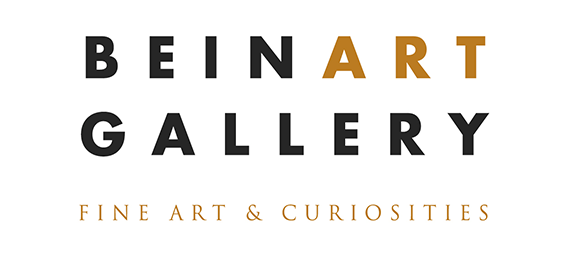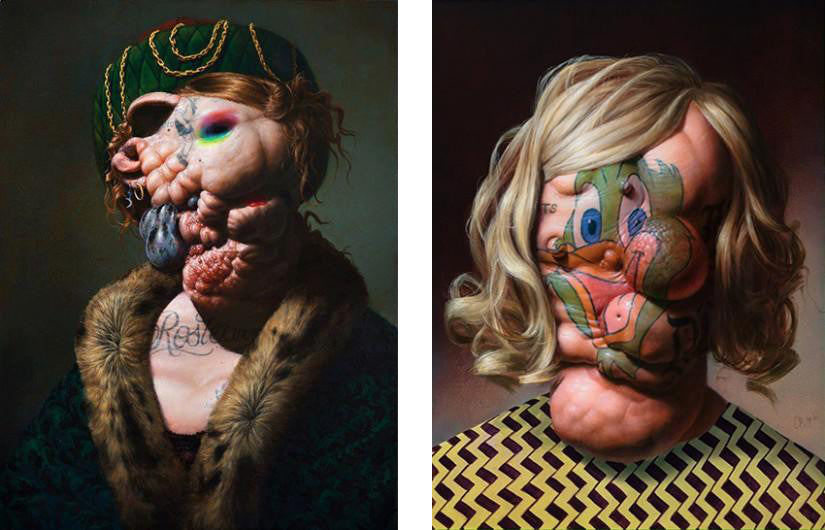
"Red & Green" - Oil painting & "Duckface" - Oil painting
To look upon the work of Christian Rex van Minnen is to imagine oneself walking down the cool, damp halls of a forgotten laboratory in the country: his paintings are part Old Masters, part mad scientist, part carnival. Classical still life and portraiture are reimagined with sumptuous beauty that paradoxically can be hard to look at. But it is van Minnen’s masterful technique and eye that draw the viewer again to consider that which looks impossible.
“I think it’s interesting to take away the eyes and mouth. In a way it makes it easier on the viewer, myself included. It allows for a more prolonged voyeurism and freedom to explore the figure. Like staring at a blind man.” —Christian Rex van Minnen
Julie Antolick Winters: In much of your work, it is as if the DNAs of various organisms have gone awry, yielding people with plant features or vice versa. How much of these arrangements do you “see” in advance of creating a painting?
Christian Rex van Minnen: I look back to history for common geometric elements in compositions and start from that. I make marks and gestures within that context and reflect on them, and that’s where the forms and textures come from. Sometimes there are some specific images or textures I know I’d like to explore in the end.
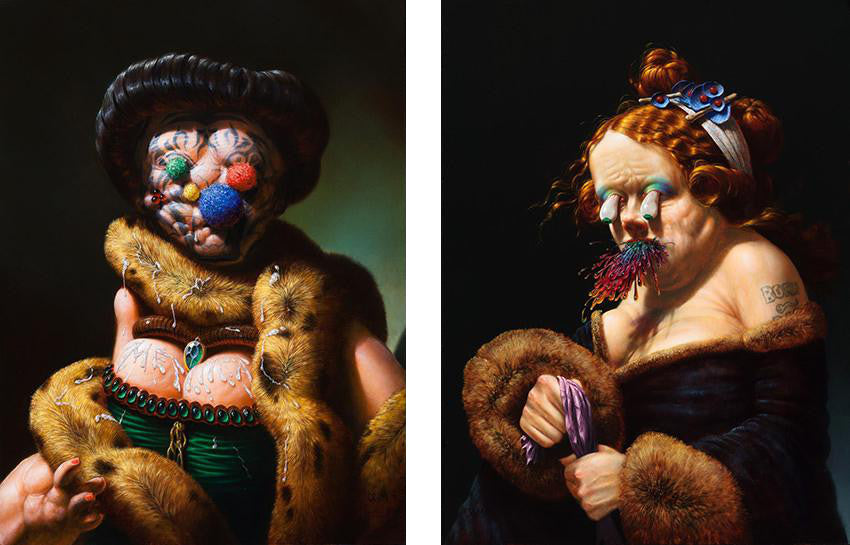
"Self Portrait With Metallica" – Oil painting & "Born Bad" – Oil painting
JAW: Can you elaborate on some of your influences? In other words, who do you turn to for that historical context?
CRvM: Right now I am inspired by the artists of the Dutch Golden Age of painting. A lot of things seem to come to a confluence in this period of painting. Many of the compositional and technical aspects are unified and perfected here. The historical context of this period also has some personal significance.
JAW: How do you balance the disparate organic elements, as well as the occasional inorganic ones, in your paintings?
CRvM: It’s intuitive, I guess. Sometimes my goal is disharmony and contrast. I like that fine line in between harmony and disharmony. Sometimes it takes a long time to find that right thing to set things off.
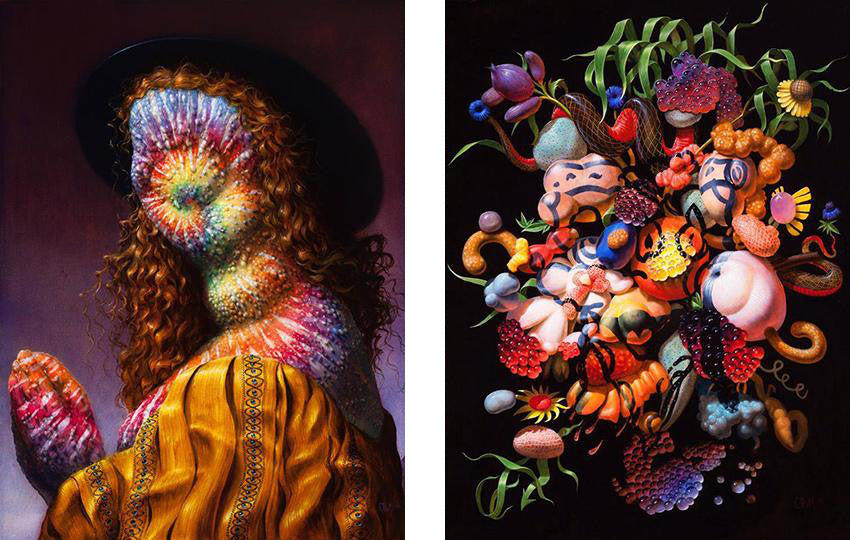
"St. Anthony's Fire" – Oil painting & "Pizza Bro Death Cult" – Oil painting
JAW: I’ve read that your work has been described as macabre, a description that you did not find apt. Yet some of your pieces are indeed challenging to look at. What do you suppose it is that leads some to call your work macabre? And would you say that this is the biggest misconception about your work that you encounter?
CRvM: I had to look up the definition of macabre to answer this question. We use a lot of language recklessly these days. Macabre describes death and injury; that’s not really what my work is about. It’s more about life, the absurd, and the tension between attraction and repulsion. I guess death plays a role in all of those things, but these paintings aren’t meditations on death alone. It’s all mixed up. I really don’t care how people perceive my work anymore; I can’t control that.
JAW: While you can’t control what the viewer perceives, what is it you wish a person to carry away from viewing your work?
CRvM: The same thing I would wish of anybody in any situation: to have an open heart, and to meet me in the middle with the best of intentions.
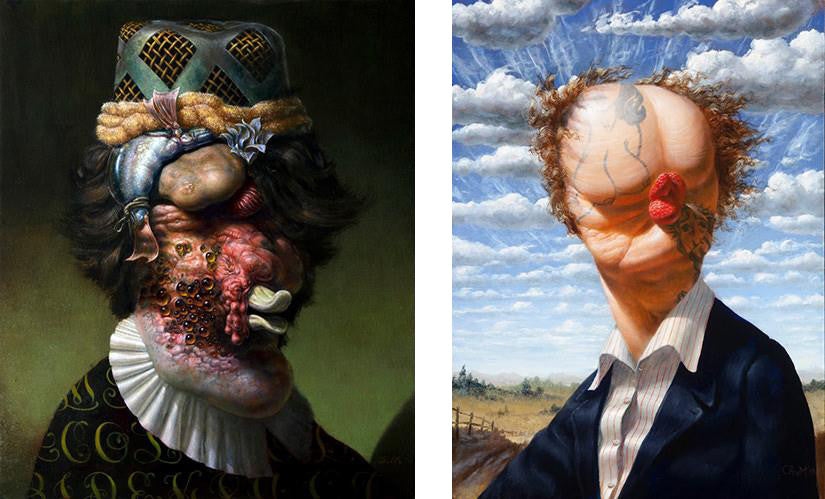
"Grody Deets" – Oil painting & "Hyperbolic Partial Differential Equation" – Oil painting
JAW: Was there ever a time you doubted your path as an artist?
CRvM: In 2006, I was working as a landscaper, pursuing a master’s degree in nonprofit management because I didn’t think anyone would ever buy my work, and struggling, without much success, to climb the ranks of the local gallery scene. It was a bittersweet but critical realization that I wasn’t an artist that would be embraced by the art world as it existed at the time. I would have to find a niche. It was at that time that I discovered how powerful a utility the Internet could be in circumventing the traditional career path as an artist. Jon Beinart was one of the first people I met online who took an active role in supporting my work, presenting it on an international level and providing that critical motivation to really pursue a career as an artist. Being a part of beinart.org was one of the first times I ever felt like I was part of a community of artists. It changed everything for me.
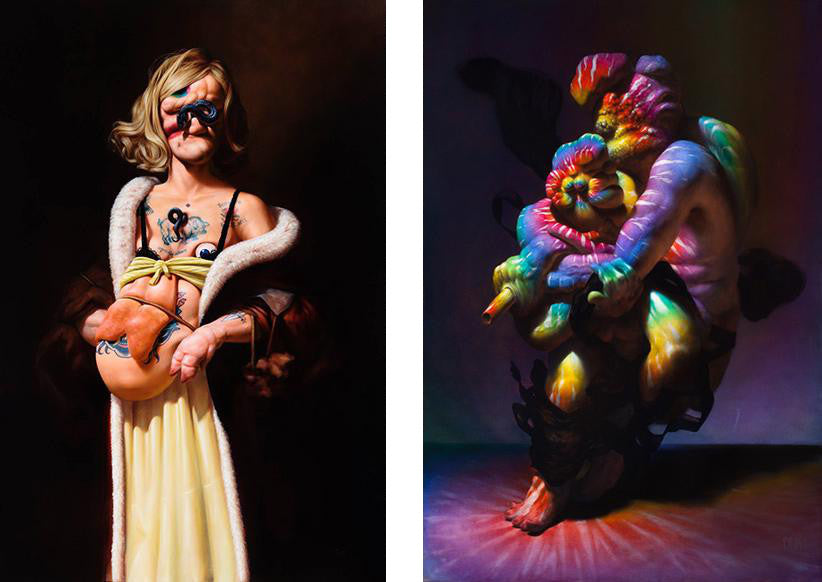
"Thunder, Perfect Mind" - Oil painting & "Hot Horror on The Dance Floor" - Oil painting
JAW: There seems to have been something of a progression in your portraits from the fantastical, with nonhuman heads, to forms in which there is certainly disfigurement and or sometimes the absence of a face, as in the Tie-Died series. Or, where there is a mouth, it is filled, or where there are eyes, they are closed or distended from the head. A constant seems to be that the subject cannot see or speak. What is behind this?
CRvM: Interesting observation. I think it’s interesting to take away the eyes and mouth. In a way it makes it easier on the viewer, myself included. It allows for a more prolonged voyeurism and freedom to explore the figure. Like staring at a blind man.
JAW: That answer almost implies that a subject who sees might somehow feel violated by a viewer’s staring. It sounds like you have empathy toward your subjects. What can you tell us about that?
CRvM: Well, I’m not sure about that. They are all me, so I don’t know how it would be possible to empathise or sympathise with yourself. I think it’s about catharsis: getting difficult emotions out, reflecting upon them. Only in your experience as a viewer could there exist empathy, or at least sympathy. If you have that response, that’s great!
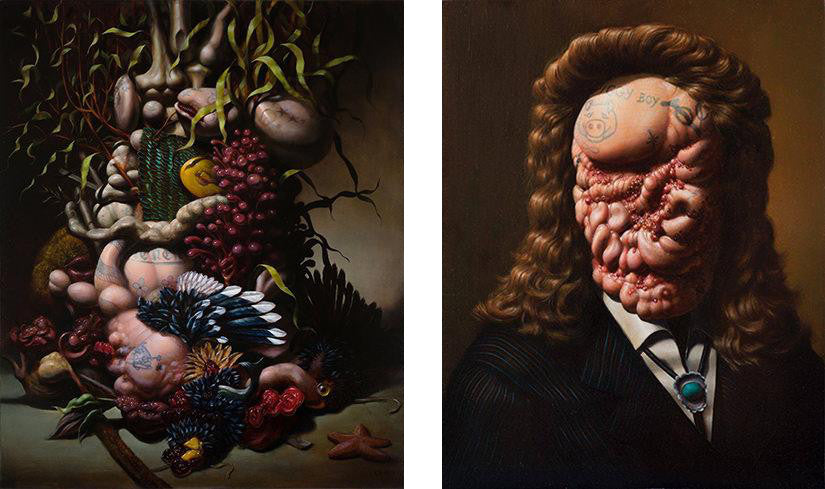
“Camp” – Oil painting & “Piggy Boy” – Oil painting
JAW: A couple of elements turn up in many of your pieces: circles with spirals in them and bead-like structures. What is the meaning of, or what is behind your attraction to, these elements?
CRvM: Sometimes there are images that I find interesting and worthy of repetition. Like saying a word over and over until it seems meaningless and alien. I like that. Sometimes, as in the case with the bead-like structures, the initial mark making in the underpainting just lends itself to these specific forms. I try not to limit that feeling of indulgence when painting.
JAW: Tell us about the tattoo work that comes up in some of your paintings. It is interesting, for example, that in some cases the tattoo is not revealed enough to be understood by the viewer. Do these tattoos have a private meaning for you?
CRvM: Not really. I like them to create an atmosphere of charged ambiguity. The tattoos are placed and chosen to match or contrast with the form and content. I really love the process of choosing the tattoos, waiting for something to click, to be just right. So much fun.
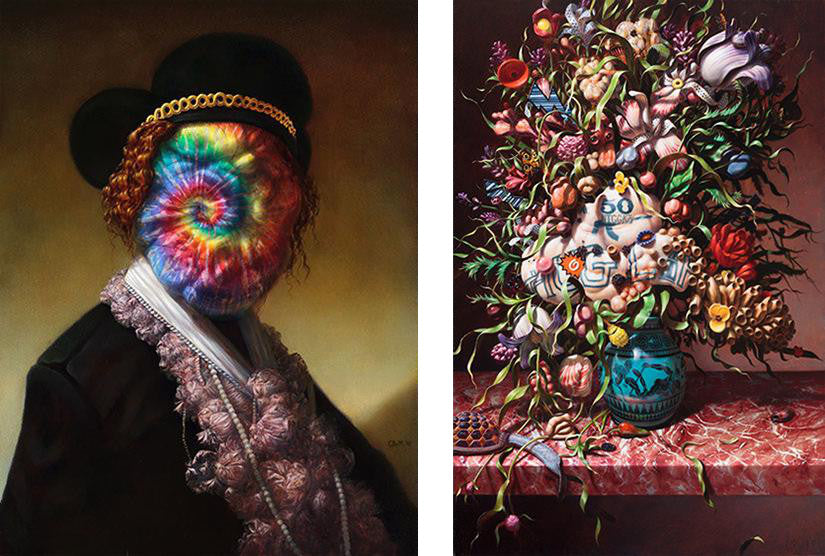
"Tie-Died 6" – Oil painting & "Still Life With Tupac" – Oil painting
JAW: Your palette seems to have gotten brighter in 2014—more rainbow colors, and there is more light. What has influenced this?
CRvM: I’ve been exploring high-chroma underpainting and glazing, just seeing where in the traditional Venetian painting process I can insert different pigments and processes. Generally, I like a limited palette with a few explosions of color. Sometimes it gets out of control. A lot of work in developing contrast in the underpainting and grisaille can make those high-chroma glazes explode.
JAW: Has becoming a father had any influence on your work that you are aware of?
CRvM: Time management. Management of time. Also, it’s given a sense of urgency to the freeing of my heart.
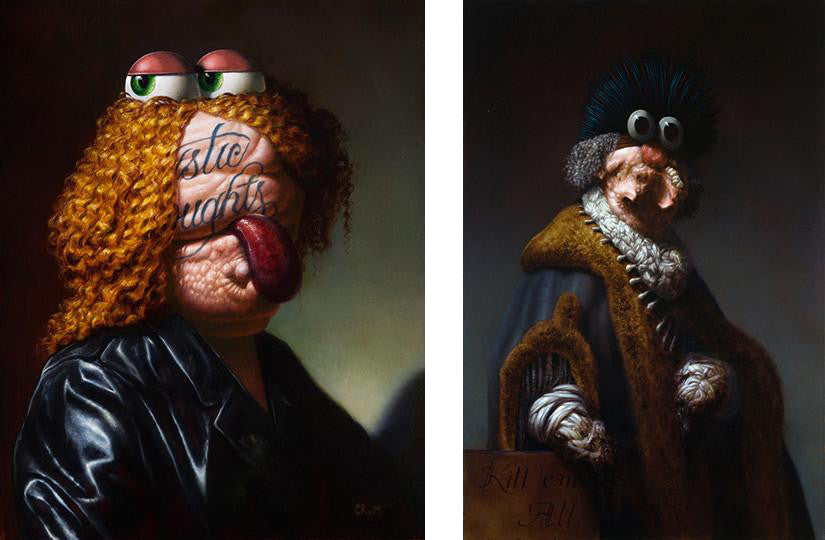
"Rational Ideas" – Oil painting & "Killing Whitey" – Oil painting
JAW: What is your hope for your future work—are there any particular envelopes you’re looking to push?
CRvM: I have no idea! Haha. I just want to get better and freer. That’s a hard line to walk.
JAW: Is there anything you’d like to share about works in progress or upcoming shows, or just what’s ahead for you?
CRvM: My next solo show is at Robischon Gallery, Denver, Colorado, January 2015. If you want to keep up on group shows and all that other stuff, follow me on social media; I use that stuff pretty regularly.
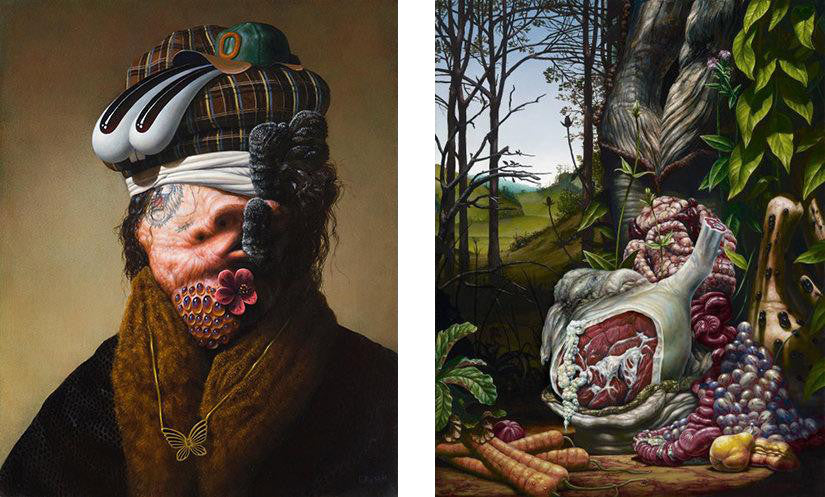
"Rushin' Lyin" – Oil painting & “Still-life 1.3” – Oil painting
This interview was written by Julie Antolick Winters for the Beinart Collective in 2014.
Julie Antolick Winters is a writer and editor residing in the state of Maryland, USA, in a small city near Washington, D.C. Julie cowrote the introduction for Black Magick: the Art of Chet Zar and co-copyedited this book and Kris Kuksi: Divination and Delusion for Beinart Publishing. She has also been conducting artist interviews for the Beinart Collective & Gallery since 2010. In addition to her work for the Beinart Gallery, she edits science articles and books, writes poetry and practices the art of negotiation with her son.




 Cart
Cart


